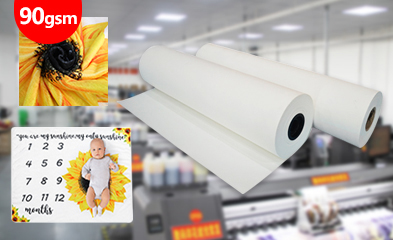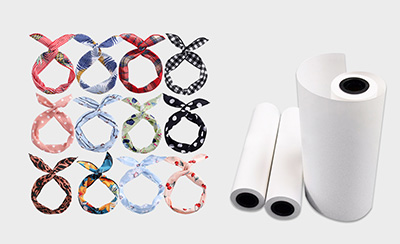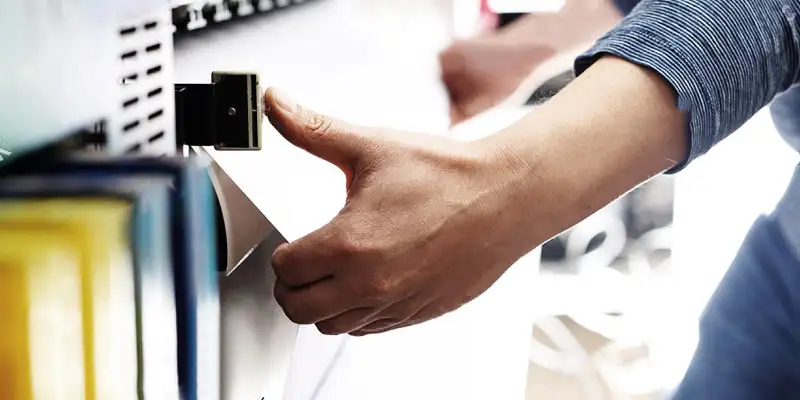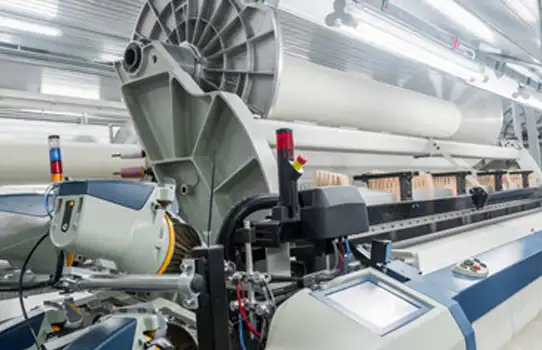HOT SALE
APPLICATION
Phone:+86-15215969856 E-Mail: 396838165@qq.com
The textile and apparel decoration industry has adopted Direct to Film (DTF) printing as its new transformative technology. The final print quality and production efficiency depends heavily on transfer paper among all other production elements. The production industry makes its choices based on the ongoing competition between hot peel transfer paper and cold peel alternatives. The article examines the fundamental distinctions between DTF transfer papers while providing detailed information about hot peel benefits and restrictions and its current applications in modern production systems.
Overview of DTF (Direct to Film) Prin
ting Technology
DTF printing has become widely popular because it produces colorful results while offering many different printing options. The printing process starts with design application to a unique film which can then be transferred onto different fabric materials through heat application.
Basic Principles of DTF Printing
The DTF printing process starts with designers applying specialized DTF inks to print designs onto PET film. The application of adhesive powder to wet ink follows printing before the ink undergoes heat treatment for curing. The heat press machine applies the film to fabric after it reaches the appropriate temperature. The film removal process requires heat application when using hot transfer paper but cold application when using cold transfer paper.
Components Involved in the DTF Process
A complete DTF setup includes several essential components: a DTF printer equipped with compatible inks, PET films (available in single-sided or double-sided variants), adhesive powders, and heat presses for transferring designs onto fabric. Item No.: DTF Ink; Color: BK, CY, MG, YL, WT; Used For: DTF Printer and Item No.: PET film (Single sided); Product model: PET film; Product type: Single sided cold tearing film are examples of such components.
Applications Across Various Industries
DTF printing serves multiple industries which include fashion apparel and sportswear as well as promotional products and home textiles. The digital paper works well for children’s bibs because it produces vibrant printed effects. The flexible nature of this material appeals to businesses that need to create small custom designs and those who require extensive commercial production.
Characteristics of Hot Peel Transfer Paper
Hot peel transfer paper has gained widespread adoption because it enables faster production while maintaining high-quality results.
What Defines Hot Peel Transfer Paper
Hot peel refers to the process of removing PET film right after pressing when it remains warm. Hot peel films enable faster workflow because they eliminate the need to wait for cooling before film removal.
Advantages of Using Hot Peel in Production
The main advantage of hot peel technology is its ability to speed up production operations. The instant removal of film after heat pressing enables manufacturers to speed up their production workflows. Hot peel papers deliver two key advantages through their ability to create smooth finishes and strong fabric adhesion. The educational materials from Hanrun Paper demonstrate that hot peel films deliver outstanding hand feel and simplify subsequent manufacturing operations.
Limitations and Considerations
Hot peel provides several benefits to users but it does not work with all fabric materials and detailed designs that need to maintain their original details. The process of hot peel requires proper handling because improper temperature control and premature peeling can damage print quality. The process needs exact temperature management to achieve its best results.
Comparing Cold Peel and Hot Peel Transfer Papers
Businesses need to understand the differences between these two types to make proper decisions for their particular requirements.
Key Differences in Application Techniques
The two types of printing materials in DTF printing workflows share identical functions yet require different handling methods.
Temperature Requirements
Hot peel papers need pressing temperatures between 150°C–165°C based on material type whereas cold peel papers operate at similar temperatures but need cooling before peeling.
Peeling Time and Methodology
The main distinction between hot peel and cold peel methods emerges from the point at which you remove the film since hot peel enables instant removal when the surface is warm but cold peel demands complete cooling before removal. The entire process duration gets substantially affected by this difference.
Durability and Finish Quality Comparison
The correct application of both types leads to long-lasting results but they differ in their surface texture and their long-term durability.
Wash Resistance and Longevity
Textile materials after transferring: Sunproof Level 6; Washproof Level 4-5. The ratings show that hot and cold peels will deliver outstanding durability when processed according to proper conditions.
Visual Texture and Feel on Fabric
Hot peel transfers create a softer texture because they bond instantly with fabric fibers which results in reduced edge lift. The process of cold peels produces more defined images but requires extended time for completion.
Choosing Between Cold Peel and Hot Peel for Different Use Cases
The choice between cold peel and hot peel methods depends on operational needs and material compatibility requirements.
Factors to Consider When Selecting Transfer Paper Type
Your decision-making process should be based on multiple factors.
Type of Fabric or Substrate
Hot peel works effectively on polyester blends because these materials maintain their structure when exposed to heat. The product details include GZP-003 as the item number and 100DIntelock as the fabric name with 153cm width and 170gsm weight and 100%T composition.
Production Volume and Workflow Efficiency
Hot peel technology provides fast peeling operations for high-volume production because it enables immediate peeling after pressing without requiring any cooling time.
Industry Preferences and Trends
Hot peel solutions have become more popular among apparel manufacturers because customers want quick production without sacrificing quality standards. The industry moves toward leaner production through automation-friendly hot peel films which support faster manufacturing times.
Integration of Hot Peel Transfer Paper in Modern Printing Workflows
Hot peel paper requires seamless integration with current systems to become a successful material adoption.
Compatibility with DTF Printers and Inks
Hot peel papers work perfectly with current DTF printers that use Adopt environmental friendly solvents and safe non-toxic inks. The papers function best with Epson I3200 and Kyocera nozzles which Changfa Digital includes in their product lineup.
Impact on Turnaround Time and Productivity
The removal of cooldown periods for cold peels enables businesses to handle more procedures during each shift thus shortening delivery times which becomes crucial during seasonal promotions and flash sales.
Introduction to Changfa Digital as a Trusted Supplier in the Printing Industry
The selection of dependable printing materials for both cold and hot peel operations depends heavily on the credibility of your suppliers.
Overview of Changfa Digital’s Product Lineup
Changfa Digital operates as a professional sublimation paper manufacturer which delivers digital printing solutions to customers for more than 12 years. The company offers industrial-grade sublimation papers with weights from 29gsm to 100gsm and roll widths from 61cm to 320cm for various industrial needs. Our main products: 40gsm, 50gsm, 60gsm, 70gsm, 90gsm, 100gsm
Sublimation Paper and Inks
Our company provides complete sublimation paper manufacturing solutions together with digital printing services.
Sublimation Printers and Heat Transfer Machines
The company operates advanced coating lines which were imported from Germany to achieve uniformity in their large production runs. The company brought in one unit of the most sophisticated coating line for sublimation paper manufacturing from Germany.
Tissue Paper for Printing Applications
The product line includes essential protective papers that serve as a requirement for heat press operations. The product features a weight of 30GSM and includes White paper with dimensions of 160cm width and 162cm/180cm/182cm length for each roll.
Commitment to Quality, Innovation, and Customer Support
Our online service features professional staff who provide immediate assistance while delivering fast results and high-quality customized products through OEM/ODM services. The service allows you to use samples for customization.
Summary of Key Insights on Hot Peel Transfer Paper and DTF Printing
Hot peel transfer paper provides businesses with speedier production times and better fabric finish quality and lower production expenses per unit while maintaining product durability when using Changfa Digital high-quality inks. The technology provides scalable growth opportunities to businesses which can be supported by suppliers who offer complete solutions from base paper production to digital printing services worldwide. Changfa Digital provides complete services that include base paper production and coating and slitting operations.
FAQs:
Q1: What is the main advantage of hot peel transfer paper over cold peel transfer paper?
A: The primary benefit of hot peel transfer paper is fast film removal, allowing immediate peeling after pressing without cooling time, enabling faster production runs while maintaining superior print quality.
Q2: Does the use of hot peel transfer paper depend on the fabric type?
A: Yes, hot peel transfer paper is ideal for polyester blends in sportswear and fashion but may not be suitable for all fabrics. For example, GZP-002 fabric (183cm width, 170gsm weight, 100% T composition) requires cold peeling due to its limited heat resistance.
Q3: Does hot peel transfer paper affect print durability?
A: No, print durability remains unaffected when hot peel paper is processed correctly. Premium inks used with hot peels achieve high wash resistance (Level 4-5), making them suitable for activewear and uniforms that withstand multiple wash cycles.


















